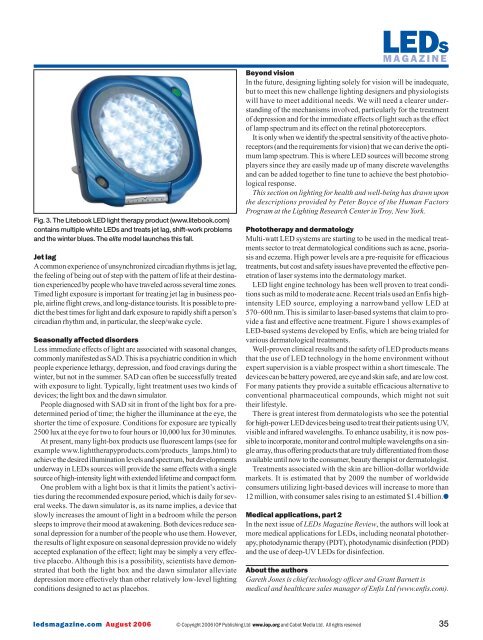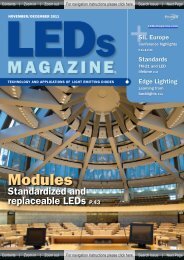LEDs Magazine Review - Beriled
LEDs Magazine Review - Beriled
LEDs Magazine Review - Beriled
- No tags were found...
You also want an ePaper? Increase the reach of your titles
YUMPU automatically turns print PDFs into web optimized ePapers that Google loves.
Fig. 3. The Litebook LED light therapy product (www.litebook.com)contains multiple white <strong>LEDs</strong> and treats jet lag, shift-work problemsand the winter blues. The elite model launches this fall.Jet lagAcommon experience of unsynchronized circadian rhythms is jet lag,the feeling of being out of step with the pattern of life at their destinationexperienced by people who have traveled across several time zones.Timed light exposure is important for treating jet lag in business people,airline flight crews, and long-distance tourists. It is possible to predictthe best times for light and dark exposure to rapidly shift a person’scircadian rhythm and, in particular, the sleep/wake cycle.Seasonally affected disordersLess immediate effects of light are associated with seasonal changes,commonly manifested as SAD. This is a psychiatric condition in whichpeople experience lethargy, depression, and food cravings during thewinter, but not in the summer. SAD can often be successfully treatedwith exposure to light. Typically, light treatment uses two kinds ofdevices; the light box and the dawn simulator.People diagnosed with SAD sit in front of the light box for a predeterminedperiod of time; the higher the illuminance at the eye, theshorter the time of exposure. Conditions for exposure are typically2500 lux at the eye for two to four hours or 10,000 lux for 30 minutes.At present, many light-box products use fluorescent lamps (see forexample www.lighttherapyproducts.com/products_lamps.html) toachieve the desired illumination levels and spectrum, but developmentsunderway in <strong>LEDs</strong> sources will provide the same effects with a singlesource of high-intensity light with extended lifetime and compact form.One problem with a light box is that it limits the patient’s activitiesduring the recommended exposure period, which is daily for severalweeks. The dawn simulator is, as its name implies, a device thatslowly increases the amount of light in a bedroom while the personsleeps to improve their mood at awakening. Both devices reduce seasonaldepression for a number of the people who use them. However,the results of light exposure on seasonal depression provide no widelyaccepted explanation of the effect; light may be simply a very effectiveplacebo. Although this is a possibility, scientists have demonstratedthat both the light box and the dawn simulator alleviatedepression more effectively than other relatively low-level lightingconditions designed to act as placebos.LEDSMAGAZINEBeyond visionIn the future, designing lighting solely for vision will be inadequate,but to meet this new challenge lighting designers and physiologistswill have to meet additional needs. We will need a clearer understandingof the mechanisms involved, particularly for the treatmentof depression and for the immediate effects of light such as the effectof lamp spectrum and its effect on the retinal photoreceptors.It is only when we identify the spectral sensitivity of the active photoreceptors(and the requirements for vision) that we can derive the optimumlamp spectrum. This is where LED sources will become strongplayers since they are easily made up of many discrete wavelengthsand can be added together to fine tune to achieve the best photobiologicalresponse.This section on lighting for health and well-being has drawn uponthe descriptions provided by Peter Boyce of the Human FactorsProgram at the Lighting Research Center in Troy, New York.Phototherapy and dermatologyMulti-watt LED systems are starting to be used in the medical treatmentssector to treat dermatological conditions such as acne, psoriasisand eczema. High power levels are a pre-requisite for efficacioustreatments, but cost and safety issues have prevented the effective penetrationof laser systems into the dermatology market.LED light engine technology has been well proven to treat conditionssuch as mild to moderate acne. Recent trials used an Enfis highintensityLED source, employing a narrowband yellow LED at570–600 nm. This is similar to laser-based systems that claim to providea fast and effective acne treatment. Figure 1 shows examples ofLED-based systems developed by Enfis, which are being trialed forvarious dermatological treatments.Well-proven clinical results and the safety of LED products meansthat the use of LED technology in the home environment withoutexpert supervision is a viable prospect within a short timescale. Thedevices can be battery powered, are eye and skin safe, and are low cost.For many patients they provide a suitable efficacious alternative toconventional pharmaceutical compounds, which might not suittheir lifestyle.There is great interest from dermatologists who see the potentialfor high-power LED devices being used to treat their patients using UV,visible and infrared wavelengths. To enhance usability, it is now possibleto incorporate, monitor and control multiple wavelengths on a singlearray, thus offering products that are truly differentiated from thoseavailable until now to the consumer, beauty therapist or dermatologist.Treatments associated with the skin are billion-dollar worldwidemarkets. It is estimated that by 2009 the number of worldwideconsumers utilizing light-based devices will increase to more than12 million, with consumer sales rising to an estimated $1.4 billion.●Medical applications, part 2In the next issue of <strong>LEDs</strong> <strong>Magazine</strong> <strong>Review</strong>, the authors will look atmore medical applications for <strong>LEDs</strong>, including neonatal phototherapy,photodynamic therapy (PDT), photodynamic disinfection (PDD)and the use of deep-UV <strong>LEDs</strong> for disinfection.About the authorsGareth Jones is chief technology officer and Grant Barnett ismedical and healthcare sales manager of Enfis Ltd (www.enfis.com).ledsmagazine.com August 2006© Copyright 2006 IOP Publishing Ltd www.iop.org and Cabot Media Ltd. All rights reserved35
















